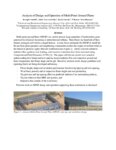TO
Filters: Collection: "ir_eua" Type: "Text"
| Title | Date | Subject | Description | ||
|---|---|---|---|---|---|
| 251 |
 |
ClearSign eye™: pilot sensor | Clearsign Technologies Corp. has developed and tested a novel, capacitive based flame sensor for use on existing burners in a variety of industrial combustion applications including process burners, boiler burners and flares. ClearSign has developed two probe designs. The first probe design is compa... | ||
| 252 |
 |
Fluidized bed pyrolysis of bitumen-impregnated sandstone at sub-atmospheric conditions | 1993-05 | fluidized bed pyrolysis; bitumen-impregnated sandstone; sub atmospheric conditions | A 15.2 cm diameter fluidized bed reactor was designed, built, and operated to study the pyrolysis of oil sands at pressures slightly less than atmospheric. Fluidizing gas flow through the reactor was caused by reducing the pressure above the bed with a gas pump operating in the vacuum mode. Pyrolysi... |
| 253 |
 |
Final report on 1989 update of the computerized geologic model to include the 1988 drill hole data Sunnyside Tar Sands project Sunnyside, Utah | 1989-07 | computerized geologic model; 1988 drill hole data; Sunnyside Tar Sands project; geologic resources | In May 1989, Rozelle Consulting Services (RCS) was requested by Amoco Corporation (Amoco) to submit a proposed scope of work for updating the 1987 computerized geologic model of the Sunnyside Tar Sands deposit (Figure 1-1 and 1-2) to include the drill hole data that was completed in 1988 by Amoco. T... |
| 254 |
 |
Atomistic modeling of oil shale kerogens and asphaltene along with their interactions with the inorganic mineral matrix | 2011-04 | atomistic modeling; oil shale kerogens and asphaltene; inorganic mineral matrix | The goal of this project is to obtain and validate three dimensional atomistic models for the organic matter in both oil shales and oil sands. In the case of oil shales the modeling was completed for kerogen, the insoluble portion of the organic matter; for oil sands it was for asphaltenes, a class ... |
| 255 |
 |
Investigative approach to address thermoacoustic vibration in gas-fired heaters and boilers | 2022 | Industrial gas-fired boilers, furnaces and heaters occasionally encounter low-frequency vibrations generated by dynamic feedback between the burner (or burners) and acoustic modes in adjacent cavities in the main combustion chamber or ductwork. Feedback occurs when pressure pulses associated with ac... | |
| 256 |
 |
Model-based design and full-scale demonstration of an oxy-coal firing system with undiluted oxygen and minimal flue gas recycle | The future use of coal as a fuel for industrial applications depends on economical technologies being made available to capture and store the CO2 emitted as a product of the combustion process. One such technology is oxy-combustion, which involves burning of the fuel using pure oxygen as the oxidant... | ||
| 257 |
 |
A volume of fluid approach to model injection of highly viscous fluids | 2022 | Despite the transition to renewable energy sources, fossil fuels will still play a significant role in satisfying the world's energy needs shortly. In addition, the rise in the demand for light distillates and the depletion of light crude oil reservoirs are shifting the interest toward the conversio... | |
| 258 |
 |
A chemical kinetics approach for heavy fuel oils gasification modelling | 2022 | surrogate; HFOs; pyrolysis; chemical kinetics modeling; Gassification | Refinery oil residue commonly considered the bottom of the barrel, can no longer be a waste. The increasing energy demand and the constant depletion of light oil supply make it crucial to find a suitable way to convert residual oils into valuable fuels. The gasification process represents a possible... |
| 259 |
 |
A bayesian decision-theory-based digital twin for methane flares | 2022 | Ground flares operate in a high-turndown, standby configuration for a significant portion of their operating life, being fully utilized only under process upset scenarios or emergencies. The low-momentum flow results in poor fuel-air mixing near the flare tip, leading to decreased overall combustion... | |
| 260 |
 |
Texas progress in flaring - 6 years of emissions data 2015 through 2020 | 2020 | Following nearly a decade of flare performance inquiry, modeling, and testing in the early 2000s, new United States Environmental Protection Agency (USEPA) flare regulations have been enacted for the petroleum refinery sector in 2012 and 2015. The stated objective of these new regulations was th... | |
| 261 |
 |
Analysis of burner operation inside an enclosed ground flare | 2022 | Thermo-Acoustic Coupling; Enclosed Flare; LES CFD Model; Noise; Premixed Burner | An industrial enclosed ground flare used as part of a large refinery project has been analyzed to assess combustion stability and performance under low and high flow conditions. This flare includes a large combustion chamber directly above the burner deck with Low Flow (LF) burners that fire up to 9... |
| 262 |
 |
Combustion emissions and thermal performance impacts when replacing hydrocarbon fuels with hydrogen in industrial furnaces | Many industrial processes rely on heating that is currently achieved through combustion of fossil fuels. The industrial sector generates approximately 23 percent of the greenhouse gas emissions in the US. As infrastructure associated with production and distribution of hydrogen continues to expand, ... | ||
| 263 |
 |
Explaining the "three inch rule": why model flares don't match full-scale | 2022 | It was Pohl and co-workers who discovered the so-called "Three Inch Rule" in their work on flares in the 1980s. They found that model flares with pipe diameter less than three inches do not have the same Combustion Efficiency (CE) and stability behaviour as full-scale flares, at least when wind is n... | |
| 264 |
 |
Capturing the effect of near-and far-field dynamics on the combustion efficiency of multi-point ground flares | 2022 | Multi-point ground flares are frequently used in scenarios where flare gas flow rates can be high and pollution (noise, light, smoke) needs to be minimized. We have applied Arches, a large eddy simulation (LES) tool that we have developed for capturing the dynamics of flares (turbulent mixing, local... | |
| 265 |
 |
Effect of operating parameters on fired heater tube skin temperature measurement accuracy & the development of new improved tube skin thermocouple | 2022 | Refineries are often faced with challenges to meet production target, improve efficiency, process opportunity crudes with limited information on fouling characteristics etc. The common parameter that often becomes constraining are the tube skin temperatures which are critical in maintaining the inte... | |
| 266 |
 |
Radiant wall burner design improvements for retrofit applications | This paper explores solutions to challenging radiant wall burner retrofit applications. For example, a significant challenge facing the combustion industry today is being able to bring old technology into compliance with new regulations without sacrificing performance. Many existing radiant wall bur... | ||
| 267 |
 |
Reduced order model of a lime kiln for fuel switching | The lime kiln is an essential part of the causticizing loop in the kraft pulp mill. It is also the last operating unit that routinely fires fossil fuels like natural gas and fuel oil. Displacing these fossil fuels with biomass like bark or sawdust is done, as is firing lignin extracted from black li... | ||
| 268 |
 |
Installation of lean premix and remote fuel staging system in industrial process heater for next generation nox emissions control | 2022 | John Zink Hamworthy Combustion (JZHC) has completed the first installation and startup of the SOLEX combustion system in the Vacuum Tower Feed Furnace at a GS Caltex refinery in South Korea. The patented SOLEX™ burner compromises a lean premix zone of combustion, where the air-to-fuel ratio (AFR) ... | |
| 269 |
 |
CFD development for fired heater applications | 2022 | Industry values the ability to ‘virtually' verify and optimize burner performance through CFD simulation and to evaluate the suitability of burner and furnace designs. Inaccurate results may lead us to falsely reject good burner designs or accept a poor design. Field problems can be far more expen... | |
| 270 |
 |
Firing of liquid bio-derived fuels for decarbonization of high temperature industrial heating processes | Recent commitments to CO2/Green-House Gas emissions reductions by governmental, NGO and industrial corporations require that new energy sources be found to replace fossil fuels. While some are envisioning ‘The Electrification of Everything,' High temperature industrial heating processes have been ... | ||
| 271 |
 |
Analysis of design and operation of multi-point ground flares | 2022 | Multi-point ground flares (MPGF) are used to process large quantities of hydrocarbon gases generated in chemical processing or petrochemical refining. These flares use hundreds of flare burners arranged and fired in a staged fashion. A wind fence surrounds the MPGF to shield the flames from plant op... | |
| 272 |
 |
Decarbonizing: the future of hydrogen firing | Historically, firing hydrogen fuel was only economical in certain applications outside of the power industry. Unlike other fossil fuels, hydrogen does not naturally exist as H2 and is commonly produced in hydrogen reformers and considered an energy carrier and not an energy source. Steam-methane ref... | ||
| 273 |
 |
Ammonia for industrial combustion | ammonia combustion; hydrogen; methane | Many companies are investigating switching from conventional fossil fuels to "green" fuels such as hydrogen to reduce CO2 emissions. This assumes hydrogen is made by an environmentally-friendly method such as electrolysis using renewable energy. However, there are concerns with hydrogen. For example... | |
| 274 |
 |
Clearsign core process burners and boiler burners - burner scaling and field results | 2022 | During previous AFRC Industrial Combustion Symposia, ClearSign Technologies Corporation introduced its ClearSign Core technology currently used in our Ultra Low NOx burner products. These ClearSign Core products have now been developed for different types of equipment applications to meet stringent ... | |
| 275 |
 |
Quantifying flare combustion efficiency using an imaging fourier transform spectrometer | 2022 | Mid-wavelength infrared (MWIR) hyperspectral imaging may be used to calculate the flare combustion efficiency from standoff measurements, without requiring any information about the fuel flow rate to the flare. Species column densities are found using a spectroscopic model, which is combined with a ... |
